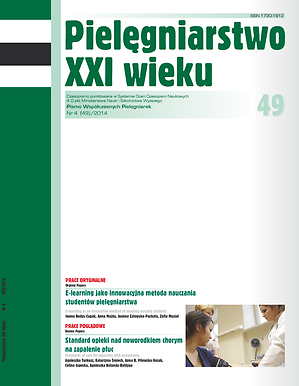Zdrowie seksualne pacjentów po przebytym zawale serca
Słowa kluczowe:
zdrowie seksualne, zawał serca, teoria systemowaAbstrakt
Przebyty zawał mięśnia sercowego to doświadczenie egzystencjalnie znaczące wynikające z sytuacji bezpośredniego zagrożenia życia. Zgodnie z definicją WHO, zdrowie seksualne zawiera w sobie biologiczne, emocjonalne, intelektualne i społeczne aspekty życia seksualnego. Zdrowie seksualne osób w tej szczególnej sytuacji życiowej zależy od wielu czynników podmiotowych i poza podmiotowych, w tym relacyjnych. Niniejszy artykuł stanowi próbę uporządkowania dostępnej wiedzy, z punktu widzenia systemowej teorii rodziny. Aktywność seksualna jest ważną sferą ludzkiego życia. Pacjenci po przebytym zawale serca przeżywają wiele niewypowiedzianych lęków o swoje życie i zdrowie. Silne negatywne emocje nasilają się przy stwierdzeniu dysfunkcji seksualnych, zwłaszcza w postaci zaburzeń erekcji. Kompleksowa rehabilitacja kardiologiczna może i powinna obejmować psychoedukację, poradnictwo, a czasem terapię seksualną i małżeńską dla pacjentów oraz ich współmałżonków. Nie chodzi jedynie o poprawę jakości życia chorych, ale też o powrót do zdrowia we wszystkich jego aspektach.
Bibliografia
1. Kośmicki MA. Choroba niedokrwienna serca w Polsce i na świecie – nierozwiązany w pełni problem. Kardiol Oparta Na Faktach. 2010; 1: 35-48.
2. Broda G, Kurjata P, Piwońska A, et al. National HES manual – in Polish (Wieloośrodkowe Badanie Stanu Zdrowia Ludności), 2013 http://www.ehes.info/manuals/national_manuals/national_manual_Poland_PL.pdf [Dostęp: 30.10.2013].
3. Wrześniewski K. Psychologiczne problemy chorych z zawałem serca. Warszawa: PZWL; 1986.
4. Opuchlik K. Ocena poziomu stylów radzenia sobie ze stresem i poczucia umiejscowienia kontroli zdrowia u osób z chorobą niedokrwienną serca i nadciśnieniem tętniczym. Psychiatr. Pol. 2009; 2: 235-245.
5. Mróz J. Zespół stresu pourazowego u pacjentów po zawale serca – przegląd badań, Folia Cardiol. Excerpta. 2009; 4(4): 200–203.
6. Piwoński J, Piwońska A, Sygnowska E. Is there an association between depressive symptoms and coronary artery disease in the Polish adult population? Kardiol. Pol. 2014; 72(1): 50-55.
7. Konieczna B, Hryńko M. Seksualność w ujęciu terapii systemowej. Seksuol. Pol. 2012; 10(1): 36-40.
8. Izdebski Z. Raport „Badanie seksualności osób po pięćdziesiątym roku życia”. Warszawa: Zielona Góra, 2007.
9. Jakiel G. Seksualność mężczyzn w okresie andropauzy. [w:] Lew-Starowicz L, Skrzypulec V, red. Podstawy seksuologii. Warszawa: Wydawnictwo Lekarskie PWL; 2010.
10. Lew-Starowicz M. Seksualność w chorobach przewlekłych. [w:] Lew-Starowicz L, Skrzypulec V, red. Podstawy seksuologii. Warszawa: Wydawnictwo Lekarskie PWL; 2010.
11. Lew-Starowicz Z, Filipiak KJ, Mamcarz A, i wsp. Kardioseksuologia. Warszawa: Medical Education; 2009.
12. Vlachopoulos C, Jackson G, Stefanadis C, et al. Erectile dysfunction in the cardiovascular patient. Eur. Heart. J. 2013; 34(27): 2034-2046.
13. Schwarz ER, Rodriguez J. Sex and the heart. Int. J. Impot. Res. 2005; 17(suppl. 1): 4-6.
14. Puchalski B, Symański F, Kowalik R, i wsp. Dysfunkcje seksualne u mężczyzn w ciągu pierwszych 9 miesięcy po przebytym zawale serca. Psychiatr. Pol. 2013; 47(5), 811-826.
15. Goławski C. Funkcje seksualne mężczyzn po ostrym zawale serca leczonym przezskórną angioplastyką tętnic wieńcowych. Warszawski Uniwersytet Medyczny. II Wydział Lekarski. Katedra i Klinika Kardiologii, Nadciśnienia Tętniczego i Chorób Wewnętrznych. Rozprawa doktorska. Promotor Prof. dr hab. n. med. Mirosław Dłużniewski. 2012.
16. Halawa B, Zdrojewicz Z. Choroba niedokrwienna serca a aktywność seksualna. Adv. Clin. Exp. Med. 2003; 12(1): 119-122.
17. DeBusk R, Drory Y, Goldstein I, et al. Management of sexual dysfunction in patient with cardiovascular disease: recommendations of the Princeton Consensus Panel. Am. J. Cardiol. 2000; 86(2): 175-181.
18. Wełnicki M, Mamcarz A. Zaburzenia erekcji: niezależny czynnik ryzyka choroby niedokrwiennej serca czy kliniczna manifestacja postępującej miażdżycy? Kardiol. Pol. 2012; 70(9): 953-957.
19. Hoekstra T, Lesman-Leegte I, Luttik ML, et al. Sexual problems in elderly male and female patients with heart failure. Heart. 2012; 98(22): 1647-1652.
20. Byrne M, Doherty S, Murphy AW, et al. The CHARMS Study: cardiac patients’ experiences of sexual problems following cardiac rehabilitation. Eur. J. Cardiovascular. Nurs. 2013; 12(6): 558-566.
21. Etapy rehabilitacji kardiologicznej. Folia Cardiol. 2004; 11 (supl. A).
22. Pawlicki B. Rehabilitacja wtórnych dysfunkcji seksualnych. http://www.urolog-krakow.pl/pdf/rehabilitacja_sex_artykul.pdf (dostęp: 20.06.2014).
23. Izdebski Z. Zdrowie seksualne mężczyzn. Wybrane zagadnienia. Seksuol. Pol. 2012; 10(1): 1-8.
Pobrania
Opublikowane
Numer
Dział
Licencja
Prawa autorskie (c) 2014 Autorzy

Utwór dostępny jest na licencji Creative Commons Uznanie autorstwa 4.0 Międzynarodowe.




